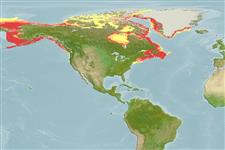>
Perciformes/Zoarcoidei (Eelpouts and pricklebacks) >
Zoarcidae (Eelpouts) > Gymnelinae
Etymology: Gymnelus: Gymnelus, derived from Greek, gymnēlos (Latinized Greek) = poor, needy (akin to Greek gymnos for destitute (E. Spencer, pers.comm. 09/13); viridis: Name from Latin 'viridis' for green' in Latin, name given by O. Fabricius due to the colour of fishes, which live in a zone of macroalgae (Ref. 123905).
Environment: milieu / climate zone / rango de profundidad / distribution range
Ecología
marino demersal; rango de profundidad 0 - 320 m (Ref. 50610). Polar; 84°N - 39°N, 180°W - 20°E
Arctic: Greenland and Canadian Arctic. Northeast Pacific: Bering Sea (Ref. 51665). Northern Atlantic: Canada and Barents Sea. Replaced by other species in the Arctic seas of Eurasia.
Length at first maturity / Tamaño / Peso / Age
Madurez: Lm ?, range 10 - ? cm
Max length : 56.0 cm TL macho / no sexado; (Ref. 4926)
Inhabits continental shelves, but generally living in shallower water (Ref. 11954); usually live over sand and muddy bottoms among seaweeds (Ref. 5951). Benthic; feeds on crustaceans, worms and clams (Ref. 58426).
Life cycle and mating behavior
Madurez | Reproducción | Puesta | Huevos | Fecundidad | Larva
Anderson, M.E., 1994. Systematics and osteology of the Zoarcidae (Teleostei: Perciformes). Ichthyol. Bull. J.L.B. Smith Inst. Ichthyol. 60:120 p. (Ref. 11954)
IUCN Red List Status (Ref. 130435: Version 2025-1)
Threat to humans
Harmless
Human uses
Herramientas
Special reports
Download XML
Fuentes de Internet
Estimates based on models
Preferred temperature (Referencia
123201): -1.5 - 4.8, mean -0.5 °C (based on 1722 cells).
Phylogenetic diversity index (Referencia
82804): PD
50 = 0.5005 [Uniqueness, from 0.5 = low to 2.0 = high].
Bayesian length-weight: a=0.00275 (0.00146 - 0.00520), b=3.19 (3.01 - 3.37), in cm total length, based on LWR estimates for this species & (Sub)family-body (Ref.
93245).
Nivel trófico (Referencia
69278): 3.1 ±0.26 se; based on food items.
Resiliencia (Referencia
120179): Bajo, población duplicada en un tiempo mínimo de 4.5-14 años (tmax=12).
Fishing Vulnerability (Ref.
59153): Moderate vulnerability (42 of 100).
🛈
